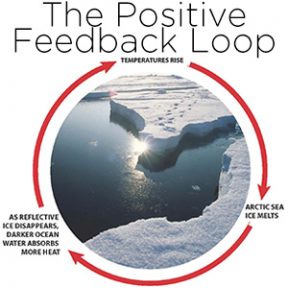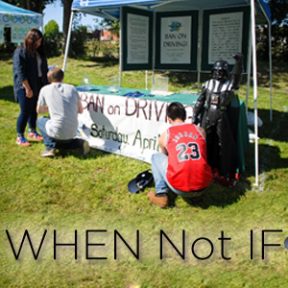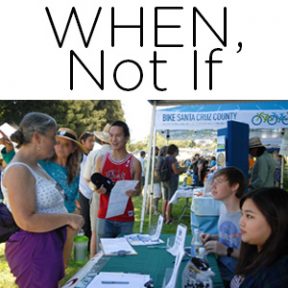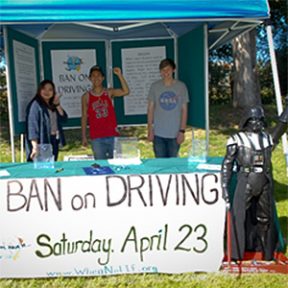 What’s the fuss about? Logan Conover, the founder of WHEN, NOT IF…, sums it up with his description about the Positive Feedback Loop. If this doesn’t scare the bejeezus out of you, I don’t think you’re listening. Leave it to a 17-year-old student to lay out the facts. Remember, DON’T DRIVE YOUR CAR TOMORROW – SATURDAY, APRIL 23RD! Go to www.WhenNotIf.org to report your stats so Logan can calculate how much CO2 we prevented from entering the atmosphere!
What’s the fuss about? Logan Conover, the founder of WHEN, NOT IF…, sums it up with his description about the Positive Feedback Loop. If this doesn’t scare the bejeezus out of you, I don’t think you’re listening. Leave it to a 17-year-old student to lay out the facts. Remember, DON’T DRIVE YOUR CAR TOMORROW – SATURDAY, APRIL 23RD! Go to www.WhenNotIf.org to report your stats so Logan can calculate how much CO2 we prevented from entering the atmosphere!
Positive Feedback Loop:
Rising CO2 levels will cause worldwide devastation similar to that of the end of the last Ice Age. To sustain human life on Earth, the ideal level of CO2 is 350 ppm. Scientists hypothesize that at 400 ppm the Earth will begin to spiral into becoming an uninhabitable planet for humans. Here is how:
Due to increased CO2 in the atmosphere, ice (white, which reflects sunlight) will melt, creating a larger ocean surface area (dark blue, which absorbs sunlight). The ocean absorbs more heat than ice does, making the ocean warmer and melting glaciers faster. This would “ultimately warm [the] global climate” because the ice on Earth stabilizes the world’s temperature, and without it the Earth’s surface would become warmer (1). This would continue in an exponentially accelerating loop until the Earth stabilized at an unknown average surface temperature too hot for humans to survive.
In March 2016 the CO2 levels reached 404.83 ppm; in October 2015 when I started research it was at 398.29 ppm. These numbers show that the amount of CO2 being produced is not decreasing, which is scary because scientists have predicted that reaching 400 ppm would be the beginning of the end of the world. Here are a few ways that climate change will affect earth.

 What’s the fuss about? Logan Conover, the founder of WHEN, NOT IF…, sums it up with his description about the Positive Feedback Loop. If this doesn’t scare the bejeezus out of you, I don’t think you’re listening. Leave it to a 17-year-old student to lay out the facts. Remember, DON’T DRIVE YOUR CAR TOMORROW – SATURDAY, APRIL 23RD! Go to www.WhenNotIf.org to report your stats so Logan can calculate how much CO2 we prevented from entering the atmosphere!
What’s the fuss about? Logan Conover, the founder of WHEN, NOT IF…, sums it up with his description about the Positive Feedback Loop. If this doesn’t scare the bejeezus out of you, I don’t think you’re listening. Leave it to a 17-year-old student to lay out the facts. Remember, DON’T DRIVE YOUR CAR TOMORROW – SATURDAY, APRIL 23RD! Go to www.WhenNotIf.org to report your stats so Logan can calculate how much CO2 we prevented from entering the atmosphere!
Positive Feedback Loop:
Rising CO2 levels will cause worldwide devastation similar to that of the end of the last Ice Age. To sustain human life on Earth, the ideal level of CO2 is 350 ppm. Scientists hypothesize that at 400 ppm the Earth will begin to spiral into becoming an uninhabitable planet for humans. Here is how:
Due to increased CO2 in the atmosphere, ice (white, which reflects sunlight) will melt, creating a larger ocean surface area (dark blue, which absorbs sunlight). The ocean absorbs more heat than ice does, making the ocean warmer and melting glaciers faster. This would “ultimately warm [the] global climate” because the ice on Earth stabilizes the world’s temperature, and without it the Earth’s surface would become warmer (1). This would continue in an exponentially accelerating loop until the Earth stabilized at an unknown average surface temperature too hot for humans to survive.
In March 2016 the CO2 levels reached 404.83 ppm; in October 2015 when I started research it was at 398.29 ppm. These numbers show that the amount of CO2 being produced is not decreasing, which is scary because scientists have predicted that reaching 400 ppm would be the beginning of the end of the world. Here are a few ways that climate change will affect earth.

 You’re probably wondering why I’ve dedicated a whole week to Logan Conover’s WHEN, NOT IF… campaign. He’s a passionate young 17-year-old student who hopes to get the world on board to reduce our CO2 emissions. With over a billion internal combustion engine (ICE) vehicles on the road today, something has to give… So if you drive a gas guzzler, consider good alternatives.
You’re probably wondering why I’ve dedicated a whole week to Logan Conover’s WHEN, NOT IF… campaign. He’s a passionate young 17-year-old student who hopes to get the world on board to reduce our CO2 emissions. With over a billion internal combustion engine (ICE) vehicles on the road today, something has to give… So if you drive a gas guzzler, consider good alternatives.
Electric motors are far superior to internal combustion engines on several levels:
- Electric motors don’t have any emissions; ICE are the cause of 20% of our CO2 problems
- Electric motors don’t have moving parts: fewer repairs and maintenance!
- Electric motors can be powered by batteries or hydrogen
- Batteries have to be charged by power plants that use fossil fuels… (terrible)
- Batteries have toxic chemicals that cause problems at the end of life (terrible)
- Solar hydrogen is produced through electrolysis using sustainable sun power (great)
- Black hydrogen is produced using steam methane reformation (Oil companies) (terrible)
It’s time to rethink what kind of vehicles we drive and make smart choices. Check out www.Kids4Hydrogen.org to learn more about how clean hydrogen will help to reduce CO2. You can also take mass transit, ride your bike, walk, or carpool.
Remember, it’s just 2 days until WHEN, NOT IF’s… big day! Don’t drive your car on Saturday, April 23rd! Then, go to Logan’s website at www.WhenNotIf.org to log in your stats. He’ll show how a grassroots effort started by a teen, can make a difference. Join him in helping to ward off Climate Change!
 Don’t drive your gas-guzzling cars this Saturday, April 23rd!
Don’t drive your gas-guzzling cars this Saturday, April 23rd!
Last weekend, Logan Conover debuted his WHEN, NOT IF… project at the Santa Cruz Earth Day festival. He met with hundreds of people to encourage them to join him in not driving their cars on Saturday, April 23rd. While some might think that Santa Cruz is filled with tree huggers and liberals, Logan was surprised to meet people who didn’t understand that driving cars causes a substantial impact on CO2 in our atmosphere. Then, there were others who have actually sold their cars and bike everywhere. The Santa Cruz Sentinel featured Logan’s project on the front page of the Sunday paper.
Logan recruited Nathan Decena, of Willow Glen High School, and Angelique Su, of Merit Academy to join him at the Earth Day event. Nathan brought a life-size Darth Vadar to attract the attention of the hundreds of children – and it worked! Kids came to the WHEN, NOT IF booth to see Darth Vadar, and their parents followed along and engaged in conversation with Logan. Visitors added their names and email addresses to Logan’s mailing list so he could remind them of future non-driving days and get their friends to join the movement.
Make plans to clear your day of all driving responsibilities on Saturday, April 23rd. Take a break from the hustle bustle of everyday life. Dust off your bikes and put air in the tires. Take the family on a bike trip or walk to your favorite beaches. Too far to walk? Take public transportation!
Then, go to www.WhenNotIf.org to enter your stats for Logan. He’ll tally this up and calculate how much CO2 we prevented from entering the atmosphere! Help Logan; help civilization as we know it. Thanks for doing your part!
 So you’re a climate change believer but feel overwhelmed by the enormity of the problem. And what’s worse? You feel like driving your little Honda Civic, or NOT driving it, won’t impact climate change, right? WRONG! With one billion internal combustion engine (ICE) cars on the road worldwide, our transportation systems are responsible for about 20% of the CO2 problems we face. Yup! That means that if everyone stopped driving vehicles for ONE SINGLE DAY, we would be preventing 29 billion lbs. of CO2 from entering the atmosphere. Just one gallon of gas produces 20 lbs. of CO2. So yes, YOU CAN MAKE A DIFFERENCE!
So you’re a climate change believer but feel overwhelmed by the enormity of the problem. And what’s worse? You feel like driving your little Honda Civic, or NOT driving it, won’t impact climate change, right? WRONG! With one billion internal combustion engine (ICE) cars on the road worldwide, our transportation systems are responsible for about 20% of the CO2 problems we face. Yup! That means that if everyone stopped driving vehicles for ONE SINGLE DAY, we would be preventing 29 billion lbs. of CO2 from entering the atmosphere. Just one gallon of gas produces 20 lbs. of CO2. So yes, YOU CAN MAKE A DIFFERENCE!
So here are 3 easy things you can do:
- Share this blog post with your family, friends, and co-workers.
- Clear your driving calendar for Saturday, April 23rd.
- Log on to WhenNotIf.org and click on the “Enter Your Data” page; enter your stats and you’re done!
Logan will post how many POUNDS of CO2 we collectively prevent from entering the atmosphere each month. So join Logan and When, Not If!

 Claim to be a Climate-Change Believer? Prove it! Don’t drive your car on Saturday, April 23rd!
Claim to be a Climate-Change Believer? Prove it! Don’t drive your car on Saturday, April 23rd!
Back in October 2015 when Logan Conover (my 17-years-old client) learned that there was 398 ppm of CO2 in the atmosphere, he was shocked. Then, when we checked CO2 levels last week and found that we reached 404 ppm in just 4 months, when we thought it would be at least 4 years, he was speechless. After all, we all know that the earth can’t handle more than 350ppm without causing havoc and heading us all into a downward spiral. But Logan actually did something about it. He started an organization called WHEN, NOT IF… to give everyone a relatively simple way to reduce their contribution to the 7.5 billion lbs. of CO2 that we spew into the atmosphere every day. Logan is advocating to get everyone to NOT DRIVE THEIR GAS-GUZZLING CARS on Saturday, April 23rd.
You can do this! Do your shopping and errands on Friday or Sunday. If you need to go somewhere, ride your bike, take a bus or train, or walk! You can even carpool with someone else! Sure, this may be a little inconvenient, but in the long term, it certainly is more convenient than, say, not having shelter because of a natural disaster that was caused by Climate Change (tidal waves, tornadoes, hurricanes, droughts, and more). So be proactive and make your plans to not drive on Saturday.
The next most important thing for you to do is to LOG IN THE MILES YOU DIDN’T DRIVE ON SATURDAY! Yup! Clever Logan created his own website for WHEN, NOT IF… and he even did the math calculations to determine how much CO2 we won’t be spewing into the atmosphere on Saturday. It’s easy to do. Just go to his website at www.WhenNotIf.org and click on the “Enter Your Data” page. Just enter how many miles you normally drive per day (approximate is fine) and how many miles per gallon your car gets. That’s it! He’s created the formula to add up your total and add it to his running tally. Can you believe that one gallon of gasoline equals 20 lbs. of CO2? Yikes!
So put this on your calendar! And please share this blog with your friends, family and co-workers! Get everyone to not drive on Saturday, April 23rd, and remind them to report their participation on Logan’s website: www.WhenNotIf.org! Logan will tally up the April 23rd numbers to determine how much CO2 we prevented from contributing to further damaging climate change!
Logan plans to expand this drive every month! With one billion cars on the road today (worldwide), the impact will be significant and it will hurt the oil industry using the only language they understand: MONEY!
 So the box says it takes only 4 hours to build – but we all know you can’t believe everything you read, right? I went back and forth about whether to buy a prebuilt shed, search for a used shed on Craigslist, or build a shed using a kit.
So the box says it takes only 4 hours to build – but we all know you can’t believe everything you read, right? I went back and forth about whether to buy a prebuilt shed, search for a used shed on Craigslist, or build a shed using a kit.
After doing considerable research, I decided to build it myself so I could get exactly what I wanted and do it that very same day (emphasis on that same day!). With my friend Mario, we finished it in 8 hours – that’s 16 man hours! Even after I read the instructions twice, I couldn’t even find the first piece. It seemed like I was reading a foreign language. Who writes instructions for kits? Then, Mario comes along and says we don’t need to read the instructions… I knew that was not a good thing, but he’s the builder and I was just glad to have the help!
I thought that by building it ourselves, it would be solid and watertight. But when I saw daylight between the seams, I knew I’d need to use a tarp to keep things dry. I guess the first mistake was not building a level slab foundation. I cracked the floor as I walked across it because it had huge gaps beneath it. Did I mention that we didn’t follow the instructions for the roof? Bad idea: the installation was a nightmare and it took twice as long. We both cracked up when I went to hold up the metal beams, but couldn’t reach them because I am vertically challenged!
Next time, spend 3 times more money and get a shed that will last!
 I love to see my students from years past; that’s one of the best parts about being a college advisor.
I love to see my students from years past; that’s one of the best parts about being a college advisor.
Gabe just graduated from Chapman University and he’s exploring solar panel systems sales while he considers going for his MBA in business.
With his engaging personality and incredible wit, he’ll be a success in whatever he path he takes.
Go Gabe!
 There have been a flurry of articles about a) Tiger Moms putting unnecessary stress on their high school children and b) the recent teen suicides in the Bay Area.
There have been a flurry of articles about a) Tiger Moms putting unnecessary stress on their high school children and b) the recent teen suicides in the Bay Area.
While I completely agree that nobody should ever have to face so much pressure that the only plausible solution is suicide – my heart goes out to those teens and their families – I do believe that the real problem is not the “pressure” but the type of work the students are doing and why they are doing it. I’ll explain why below – stay with me.
Somewhere along the line a long time ago, parents “heard” that a student was admitted to Harvard because he was the MVP for a sport – so then all of the parents rushed to put their kids in a sport, or two, or three! After school, kids’ schedules were mired in practices and private lessons for several sports: basketball, tae kwon do, dance, competitive basket weaving, etc. The kids were neither improving their skills nor really enjoying the activities because they were so overscheduled.
Then, parents “heard” that a student got into Stanford because she took 10 AP classes – and you got it, all of the parents pushed their kids to take more and more AP classes to improve their kids’ chances of getting into Stanford.
But the problem we’re facing today is that nobody’s asking if the kids are learning or engaged in their studies. Have you ever looked at the curriculum for AP classes? I have, and it’s pretty dismal. The students spend the entire school year preparing for the AP test in May. Teachers can’t indulge students with fascinating tangents or interesting related topics because they can’t “waste time covering material that will not be on the exam.” Well, it doesn’t take a genius to figure out that the AP classes are all about memorizing facts, practicing writing essays using the style and format required for the course, and spending 8 months drilling for that test.
Forget about exploring the subject or writing comprehensive research papers to give the students the intellectual freedom to engage in the material. Nobody cares about whether or not the student finds the subject stimulating; all the parents and teachers care about is the score at the end of the year. Hmm.
Let me give another example. When parents “heard” that a student got into Yale because she started a club and participated in a few others at school, parents started pushing their kids to join clubs just for the sake of joining them. The students often didn’t even go to the meetings and nobody kept track of attendance because it was all for show. Most kids that I work with tell me that they don’t really know what’s going on in the clubs and that they might show up for 30 minutes during lunch once a week. Jack of all trades, master of none!
And finally, everyone knows that grades and SAT/ACT scores are the main criteria by which colleges determine who gets in and who doesn’t. So, parents pay oodles of money for their children to spend countless hours for tutoring in classes and SAT/ACT prep. I remember a student who was in tears because she got a 2370 on her SAT I. Hellooooo – a 2400 is a perfect score. When she told me she was upset because 6 other kids at her school got a 2400, I was flabbergasted. Imagine not being happy with a 2370?
When our children are pressured into doing all of the above, it’s no surprise that they are depressed and stressed out. They are worried that they won’t get into their dream college if they don’t excel in sports, AP classes, SATs/ACTs, and get the perfect GPA. But they’re also stressed out because they’re spending their precious time doing things they aren’t engaged in. If the students get to choose what classes are interesting to them and spend time exploring various fields and concepts, they wouldn’t be as stressed out. We’d have to pull them away from it! Chasing impossible scores or grades is stressful because most students don’t succeed at that. But reading books that they love or tinkering on projects that fascinate them is a healthy and innovative way to spend their time.
The good news is that the top colleges in the United States also recognize this. After all, colleges don’t want entering freshmen to be burnt out from 4 years of AP classes and overloaded extracurriculars. These types of students only fizzle out when they arrive on college campuses. Instead, these excellent universities want students who are engaged and as a result, are interesting young adults. Many colleges no longer give more weight to students who have more than a couple AP classes or after-school activities. They know students can’t really be focused on 15 AP classes, 10 school clubs, and 12 volunteer gigs; it’s impossible.
I recommend that college-bound students take interesting classes that give them a taste for potential careers, while also taking foundation classes so they enter college with a strong academic background. For extracurriculars, I help the students do one project that absolutely fascinates them (not their parents or what they think the colleges would like to see). That way, they’ll have time to enjoy doing research and developing their projects. This makes for happier students who can learn more and do it with considerably less stress! read more
 Every day I hear more evidence about our planet warming up and that it is caused by us – humans. NASA scientists are concerned about a growing crack in the Nansen Ice Shelf that may break off and create a massive iceberg the size of Manhattan. Over the past 2 years, this small crack has spread across the entire width of the shelf, which is about 20 miles wide and 30 miles long. The rate of ice shelf loss has been speeding up according to ScienceAlert. Over the past 20 years, Antarctica’s Larsen ice shelves have lost about 75 percent of its land mass.
Every day I hear more evidence about our planet warming up and that it is caused by us – humans. NASA scientists are concerned about a growing crack in the Nansen Ice Shelf that may break off and create a massive iceberg the size of Manhattan. Over the past 2 years, this small crack has spread across the entire width of the shelf, which is about 20 miles wide and 30 miles long. The rate of ice shelf loss has been speeding up according to ScienceAlert. Over the past 20 years, Antarctica’s Larsen ice shelves have lost about 75 percent of its land mass.
Others may argue that the Nansen Ice Shelf is just 0.1% of Antarctica’s ice shelf coverage, NASA researchers want to continue studying why ice shelves collapse and how to prevent it. I’m worried that massive ice shelves are breaking away in Antarctica and Greenland/Arctic regions. We need to drastically – and quickly – reduce our CO2 levels in order to stop inevitable catastrophic disasters in the near future.
 For students who have good study skills and can maintain a 3.0 GPA or higher in high school, taking a college class during the summer can give them a taste for what college might be like. I find that it gives teens a sense of independence and usually motivates them to strive to improve themselves.
For students who have good study skills and can maintain a 3.0 GPA or higher in high school, taking a college class during the summer can give them a taste for what college might be like. I find that it gives teens a sense of independence and usually motivates them to strive to improve themselves.
The good news: teens can register for classes without going through the intense application process to enter as a freshman full-time student. All you need is your high school counselor’s signature on a Verification Form and the course information on the summer class you’d like to take. Easy Peasy.
Most community colleges and 4-year universities will be posting their summer courses and schedules of classes in the next few weeks. Choose classes with the following 3 things to keep in mind:
- Does the class time (including transportation and parking) conflict with my job or other responsibilities during the summer?
- Are there prerequisites (classes that you need to take before you can take the summer class)?
- Can I be successful in this class? Read the course description and syllabus (if you can find it online) to make sure you can handle the midterms, finals, essays, and/or projects required for the course.
- Will this class satisfy a GE (general education requirement for my future college)? It’s best to take classes that satisfy most college GE requirements like English 1A, US History, World History, Political Science, Psychology, Sociology, Economics, Math, Statistics, Art, etc.
- If you know your major, take one of the lower division prerequisites. Go to your favorite college website to get a list of the lower division courses required for the major. Getting these courses completed while in high school can save you big bucks and get you to your graduation sooner – also saving more money!
Classes fill up quickly, and most full-time students have seniority over high school students, so start looking at course offerings now. You can even stay on campus if you’d like the full college experience or stay at home and just take the class on campus. I wouldn’t take more than one college class per term; take it slowly and enjoy your experience!










